
How to Ask for Reviews
Modern consumers use online research to learn more about a product they’re interested in purchasing, a service provider they might hire, or a business they’re interested in working with before they make a decision.
Online reviews are critical to this decision process and are frequently referenced by consumers throughout this journey. Research shows that more consumers than ever before are reading reviews, with 77% saying that they always or often seek out business reviews when researching a product or service.
The vital role reviews play in the purchase process means that all local businesses can benefit from knowing how to get more customer reviews. The good news is that most consumers are open to leaving a review when asked — so building a strong review profile is entirely possible once you know how to ask for reviews in a way that connects with today’s consumers.
How do you ask for a five-star rating?
Many platforms have specific guidelines setting out what you can and can’t do when asking for reviews (with some completely against soliciting reviews from customers). What’s common for all review requests is that you shouldn’t specifically ask for a five-star rating (or another specific rating). Instead, you should politely request that the customer shares their honest feedback detailing their experience with your business. You can do this in a number of ways, such as via email, SMS, or at the point of sale.
How do you politely ask for a review?
No matter the format you choose to communicate with your customers, you should begin by thanking the person for choosing your business. Keep your request short and succinct and provide a link to your chosen review platform for convenience. Add that their feedback is valued, helps you to improve your services, and ends by thanking the individual for their time.
How to Get More Customer Reviews
There are a few vital elements that go into getting more customer reviews, including knowing how to approach your customers to ask for their feedback.
Related: Free Online Video Course – ‘A Beginner’s Guide to Generating and Managing Reviews‘
One of the most important aspects actually begins before you ask for a review, and this is the act of delivering an excellent customer experience. Focusing on this is the best way to create a positive impression, which can then be translated into a great online review.
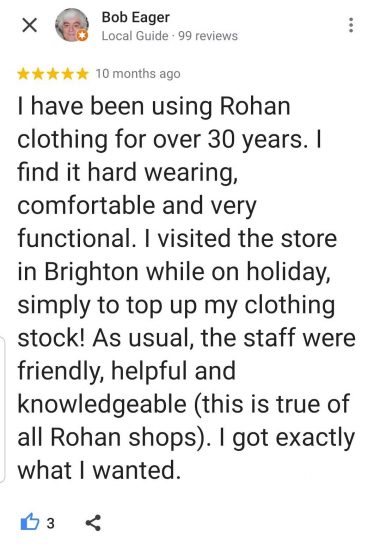
Don’t Be Afraid to Ask!
Our research indicates that 12% of consumers will always leave a review when asked to do so by a business, with 35% saying they’ll leave a review at least half the time if asked. While some customers will take it upon themselves to leave a review for your business without being prompted, others won’t. So it’s important that you get into the habit of always requesting reviews from your customers.
There are a number of ways you can do this, including face-to-face, at the point of sale, via email, or via text. Make it a priority to ask for feedback at some point during all business transactions using the method that seems most appropriate for that particular customer.
Experiment With Different Ways of Asking for Reviews
Today’s consumers are used to communicating with businesses in a number of different ways, including on social media, in a text message or messaging app, via email or in person. It’s beneficial to know how to ask for reviews through a number of different mediums as this gives you a range of tactics that you can deploy depending on the customer and the situation.
-
Ask for Reviews in Person
Asking for reviews in person may be the easiest and most convenient method if you run a brick-and-mortar business, or a service-area business, such as an HVAC repair firm, plumbing service, or pool cleaning company.
This can be achieved as easily as verbally asking your client to review you once the job is complete or the item has been purchased. You could additionally add a link or QR code to your invoice or cash register receipt, or display a poster that a customer can scan before leaving the premises to provide a review. Having a tablet at the side of the register that you can direct customers to after requesting a review, is a good way to ensure your in-person request leads to an actual review.
Ideally, all review requests will take an omnichannel approach in order to capture as much feedback as possible. With that in mind, aim to follow up an in-person review request with a different method of communication, such as email or SMS.
- Ask for Reviews by Email
It’s quick, easy, and convenient to ask for reviews via email, especially if you automate the process by using a review management tool. You can also make life easier for yourself by having a few review request email templates drafted up and ready to go.
Your email request should ideally come soon after the interaction with your business. Don’t be afraid to follow up a few days later if a consumer isn’t responsive to your first email.
- Ask for Reviews by SMS
If you have telephone contact information for your customers, you can use SMS to request a review. With email inboxes increasingly filled, and cell phone use growing, SMS offers a creative alternative to email.
- Ask for Reviews on Your Website
Whether you’re already familiar with how to ask for reviews or you’re new to the task, having a page on your website that links back to your review profiles is a great idea. Be sure to include a call to action inviting visitors to share their feedback. This tactic can also be used in email signatures and on social media.
- Encourage Live Chat Agents to Ask for Reviews
If you have a live chat option on your site, then your customer service agents can also ask for reviews after they have successfully dealt with a query. If you have a chatbot rather than a human team, you should be able to add in a simple review request instruction.
- Include a Review Request on Your Business Card
If you hand out business cards to customers — and have some space left on your card — you can add a line requesting a review alongside an icon of your preferred review platform.
- Request Reviews on Invoices and Printed Receipts
Whether you provide a customer with a printed receipt or invoice, you can also use this document to request a review. This will often reinforce other mediums, such as an email request.
- Use NFC and Link Mode
If you have BrightLocal’s Reputation Manager and an NFC box at your location, you can connect the two to ask for reviews via NFC.
Don’t Wait Too Long Before Asking for a Review
Keep in mind that simply asking for a review may not always get you the results you want. Building a review generation strategy that focuses on growing reviews requires thinking about the when, the why, the how, and the way that reviews are asked for.
A common mistake is to wait too long before you ask for a review. Reaching out to customers three months after you’ve done business with them isn’t likely to bring you much success. Ensure you’re asking your customers for feedback immediately after the transaction or soon after in a follow-up email.
Offer a Variety of Review Platforms
Another key consideration when asking for reviews is where consumers are directed to. Optimizing this aspect of your review requests gives you a much better chance of gathering more reviews.
The secret to success lies in being able to offer a variety of review platforms. If you only have Tripadvisor set up, or restrict customers to just Facebook Recommendations, the consumers that don’t have the relevant account or aren’t familiar with the platform could be discouraged from leaving a review.
If you haven’t already, establish profiles on Facebook, Yelp, Google Business Profile (formerly known as Google My Business), and any niche online review sites that apply to your industry, such as RateMDs.com, Angi, or UrbanSpoon.
Making it easy for consumers to find a platform they’re comfortable with can be as easy as creating a dedicated page on your website. This page can contain links to your profiles on Yelp, Google, and other review sites, or install widgets on your homepage or service pages. Include a message that prompts visitors to write a review using the platform of their choice, but do keep in mind that the rules around soliciting reviews are different for each platform.
It’s much easier to transform verbal testimonials into positive online reviews when you offer a variety of platforms. Whenever you receive positive feedback from a customer in an email, in person, or on the phone, get into the habit of asking the customer if they would mind turning their comments into an online review. Check which platform they prefer and then simply email them a link to that profile.
To go even further, add links to your review platform profiles to your email signatures, order confirmation pages, and social media pages.
Respond to Reviews
Responding to the reviews your business receives is an important part of building a strong review profile. Doing so can encourage other consumers to leave their review, too.
Responding to reviews allows you to publicly demonstrate that you value feedback. With 57% of consumers saying they would be very or fairly unlikely to use a business that doesn’t respond to reviews, it can make the difference between cementing a consumer’s opinion of your business and having them decide to take their buying power elsewhere.
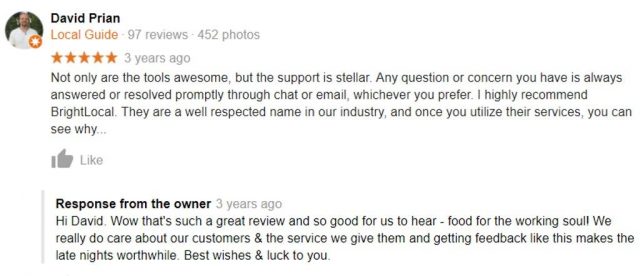
Responding to negative reviews is just as important as acknowledging positive comments, so don’t be tempted to ignore them. Our guide to dealing with negative reviews is a very useful resource if you’re unsure about how to do this.
Note: It is against Google’s guidelines to incentivize the removal or revision of a negative review.
Ask Specific Questions
There’s a world of difference between knowing how to get reviews and knowing how to get great reviews that are full of useful details for consumers and Google’s local SEO algorithms alike.
Including specific questions within your review request can help your consumers to leave more detailed reviews, which are more likely to include helpful information that readers of those reviews could expect to see.
For example, if you’re a bar owner, you could ask what the guest’s favorite drink on the menu was, Or, if you’re running a hotel business, ask which amenity the customer most enjoyed. You could even ask if there was a specific team member that deserves a shout-out. These prompts tease out very specific nuggets of information that add richness and depth to the review.
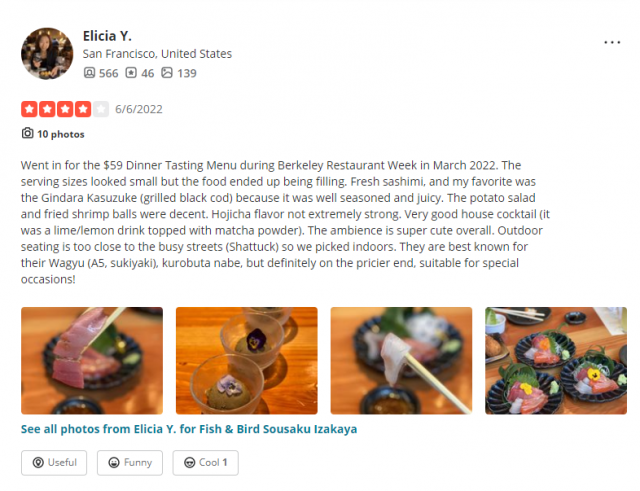
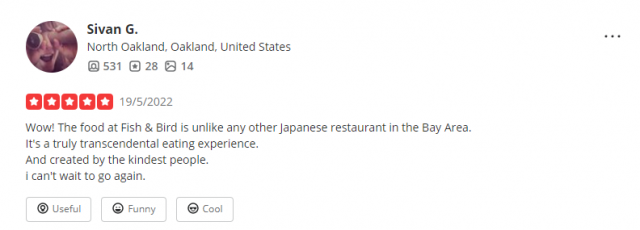
Let Reviewers Know How Long a Review Will Take
The last thing you want is to have someone abandon their review because they hadn’t realized just how much time it would take them to complete. Including an estimate of how long it will take to leave a review will ensure each reviewer goes into the platform knowing they’ll need to set aside a certain amount of time.
Some platforms ask for way more information than others, so if it’s the case that you have a more time-intensive review platform, such as Tripadvisor, add a second speedier option for time-poor reviewers to use instead, such as Yelp.
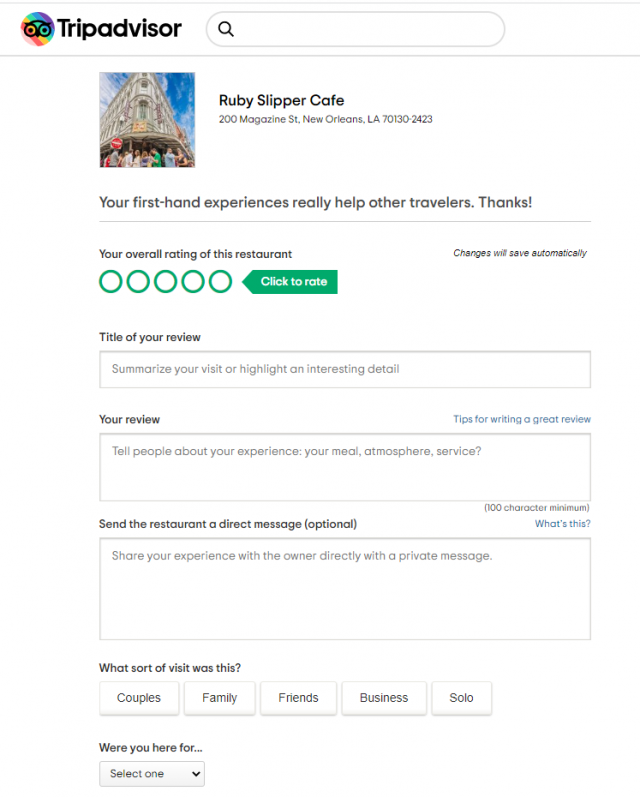

Use Marketing Materials Provided by Review Platforms
If your chosen review platform offers marketing materials, such as printed stickers, door hangers, posters, menu inserts, and so on, make use of those assets in your place of business.
Google has a free marketing kit, while Tripadvisor also has a range of marketing materials that are ready to use, such as posters and stickers.